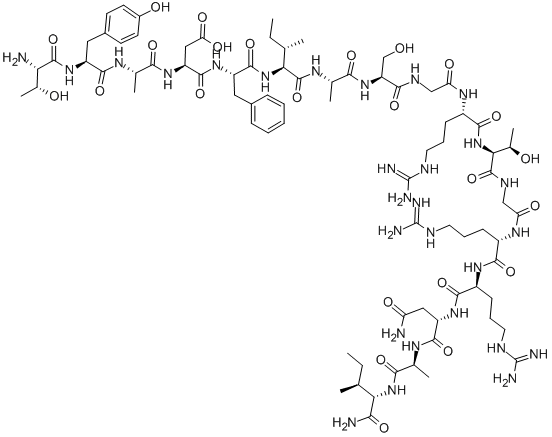Uses
Protein Kinase A Inhibitor Fragment 6-22 amide has been used as a PKA inhibitor:
- to study its effects on oocytes in two-electrode voltage clamp (TEVC) experiments
- to study its effects on antinociception levels in mice
- in PKA phosphorylation assay
Biological Activity
ki: 1.6 nmpka inhibitor fragment (6-22) amide is a pka inhibitor.in cell biology, protein kinase a (pka) is a family of enzymes whose activity is dependent on cellular levels of cyclic amp (camp). pka is also regarded as a camp-dependent protein kinase. pka has various functions in the cell, such as regulation of sugar, glycogen, and lipid metabolism.
in vitro
compared with (ala)kemptide, pka inhibitor fragment (6-22) amide was found to have significant difference in inhibitory potency, likely due to the critical role of several of the nonarginine residues to this difference in potency. the minimal length analog of pka inhibitor fragment (6-22) that inhibited camp-dependent protein kinase with high potency was the 17-residue pki-(6-22)-amide. pka inhibitor fragment (6-22) interacted at the peptide/protein binding portion of the active site in a competitive manner with a low nanomolar ki value. to inhibit camp-dependent protein kinase, pka inhibitor fragment (6-22) required both the pseudosubstrate site (residues 14-22) and additional nh2-terminal determinants within residues 6-13. pka inhibitor fragment (6-22) could clear mimic protein and peptide substrates in interacting with the binding region of the active site particularly in the cooh-terminal pseudosubstrate basic domain. undoubtedly, the overall affinity of pka inhibitor fragment (6-22) was due to the number of hydrogen bonds as well as other bonding interactions with the active site of the camp-dependent protein kinase [1, 2].
storage
-20°C (desiccate)
References
[1] glass et al (1989) primary structural determinants essential for potent inhibition of camp-dependent protein kinase by inhibitory peptides corresponding to the active portion of the heat-stable inhibitor protein. j.biol.chem. 264 8802. pmid: 2722799.
[2] glass et al (1989) protein kinase inhibitor-(6-22)-amide peptide analogs with standard and nonstandard amino acid substitutions for phenylalanine 10. j.biol.chem. 264 14579. pmid: 2760075.
